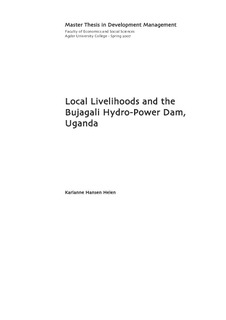Local Livelihoods and the Bujagali Hydro-Power Dam, Uganda
Master thesis
Permanent lenke
http://hdl.handle.net/11250/135129Utgivelsesdato
2007Metadata
Vis full innførselSamlinger
Sammendrag
Previous experience with dams shows that the local population carry a high proportion of the
burden related to such projects. This paper intends to investigate the risks of impoverishment
among the project-affected people in the resettled and downstream settlements who are in the
fishing or agriculture sectors.
Earlier empirical research provided the paper with a framework to build the data collection
and to analyse the findings together with the following two models: The Impoverishment
Risks and Reconstruction model and the Sustainable Livelihoods approach. The first one
provided the research with concrete indicators of impoverishment, namely landlessness,
joblessness, food security and marginalisation. The latter further expanded the framework by
allowing a broad analysis incorporating several elements which constitute a livelihood
situation as well as affecting the method used in the research. The data collection is mainly
based on interviews with complementary case studies.
The analysis found that the resettled population have experienced a relatively high degree of
impoverishment, and that it is mainly caused by the adverse effects on the status of their
assets. The compensation they received has not been able to restore or improve their
livelihoods and the site for the resettlement offers few possibilities for the resettled to
counteract the impoverishment. The population is experiencing isolation, both geographically
and regarding the ability to affect their own livelihoods. The downstream settlements face a
moderate risk of impoverishment by the dam. The potential adverse effects on the fisheries
and a lack of access to uncontaminated water are the main effects of the dam constituting this
risk. However, the research suggests that impoverishment can be reversed, mainly by
expanding the options of the project-affected people by crating opportunities for alternative
livelihood activities. Measurements can also be taken to ensure the access to basic needs,
especially water and health care.
This paper has used the Sustainable Livelihoods Framework for further investigation of the
context in which the impoverishment in the resettled area and the risk of impoverishment in
the downstream are prevalent. The framework presents three components; vulnerability
context, transforming structures, processes and assets which all contribute to the livelihood
strategies and outcome of the project-affected people. The relationship between these proves
to be dynamic and complex. These components do not create favourable livelihood outcome
for the project-affected people, as they only display limited possibilities to counteract the
adverse impacts of the dam. However, these components enabled this paper to identify the
most important factors that influence livelihood outcomes. This will make it easier to find
proper measurements to counteract the adverse impacts.
Beskrivelse
Master's Thesis in Development Management - Agder University College, 2007
Utgiver
Høgskolen i AgderAgder University College
